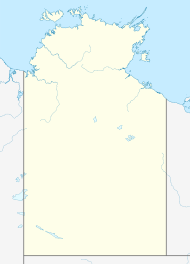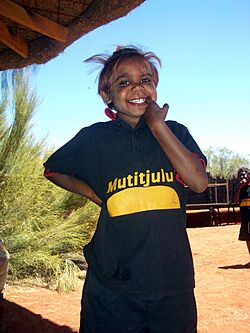Mutitjulu facts for kids
Quick facts for kids MutitjuluNorthern Territory |
|||||||||
|---|---|---|---|---|---|---|---|---|---|

Mutitjulu welcome sign
|
|||||||||
| Population | 296 (2011 census) | ||||||||
| Postcode(s) | 0872 | ||||||||
| Elevation | 523 m (1,716 ft) | ||||||||
| Location |
|
||||||||
| LGA(s) | MacDonnell Shire | ||||||||
| Territory electorate(s) | Namatjira | ||||||||
| Federal Division(s) | Lingiari | ||||||||
|
|||||||||
Mutitjulu is an Aboriginal Australian community in the Northern Territory of Australia. It is located at the base of Uluṟu (also known as Ayers Rock), right next to a special water-filled rock hole that gives the community its name.
The people of Mutitjulu are the traditional owners of this land. They work together with Parks Australia to manage the famous Uluṟu-Kata Tjuṯa National Park.
Contents
The People of Mutitjulu
The people who live in Mutitjulu are known as Anangu. Most Anangu are Pitjantjatjara, but some are also Yankunytjatjara, Luritja, and Ngaanyatjarra. These groups have a deep connection to the land and to Uluṟu.
Languages Spoken
In Mutitjulu, people speak several languages, including Pitjantjatjara, Luritja, and Yankunytjatjara. These languages are part of the Western Desert Language group, so they are similar enough for people to understand each other easily.
Many residents also speak some English because they meet tourists who visit Uluṟu. This helps them share their culture with people from all over the world.
A Special Relationship with Uluṟu
For the Anangu people, Uluṟu is a very sacred place. It is not just a giant rock, but a living, cultural landscape full of stories.
These stories, known as Tjukurpa, are part of the dreamtime. They explain how the world was formed, how people should behave, and describe the plants and animals in the area. Many of these important stories are shared through songs, ceremonies, and beautiful paintings.
Caring for a Sacred Site
The Anangu see themselves as caretakers of Uluṟu, not owners. For many years, they asked visitors to show respect for its sacred status by not climbing it.
In 2017, the park's board, which includes Anangu leaders, decided to officially stop the climb. The climb on Uluṟu was permanently closed on October 26, 2019. This was a very important day for the Anangu people.
Return of the Land
For a long time, the Anangu were not in charge of the national park. But they worked hard to have their land rights recognized.
On October 26, 1985, the Australian government officially returned the ownership of the Uluṟu-Kata Tjuṯa National Park to the Anangu. Today, they manage the park together with Parks Australia, making sure the land and its culture are protected.
Sharing Culture with Visitors
The Mutitjulu community helps tourists learn about their culture and the importance of Uluṟu. They run special guided tours called Anangu Tours. On these tours, they show visitors important sites and share the stories of the land.
To visit the Mutitjulu community itself, you need special permission from the Anangu. This is to protect the privacy of the people who live there.
Art and Music from the Community
Art is a very important part of life and the economy in Mutitjulu. It's a way to tell stories, share culture, and earn a living.
Maruku Arts & Crafts
Maruku Arts & Crafts is an art centre owned and run by Anangu. It helps almost 900 artists from remote communities in central Australia sell their work. They are famous for their amazing paintings and detailed woodcarvings.
The art centre has a gallery at the Uluṟu-Kata Tjuṯa National Park Cultural Centre. Its goal is to keep the culture strong for future generations and to share it with visitors in a real and meaningful way.
In 2017, artists from Maruku created the beautiful artwork for the Uluru Statement from the Heart, an important document for Aboriginal and Torres Strait Islander people.
The Mutitjulu Band
The community also has its own musical group, the Mutitjulu Band. Led by Kimberley Taylor and David Honeymoon, the band has performed at many events. They have even recorded songs at the ABC studios in Sydney and have become popular with many listeners.
Education in Mutitjulu
The community has a school for students in primary school. For high school, students can attend Nyangatjatjara College.
The college respects Anangu cultural traditions. For example, during their teenage years, boys and girls are taught in separate groups. This helps them learn in a way that follows their cultural customs.
See also
 In Spanish: Mutitjulu para niños
In Spanish: Mutitjulu para niños



